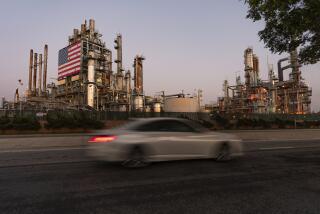California Motorists See 9-Cent Leap in Gas Prices
- Share via
California drivers are paying nearly a dime more at the pump than they were a week ago, the Energy Department said Tuesday. Gasoline station operators blamed the big oil companies, which in turn blamed stubbornly high oil prices, minor refinery headaches and heavy end-of-summer demand.
Weakening gasoline consumption in coming months could help bring gasoline prices down unless crude oil prices, which briefly flitted above $34 a barrel Tuesday, refuse to cooperate, energy analysts say.
But even people who analyze energy prices for the government are having trouble pinning down the reason prices on California’s spot gasoline market have soared in the last two weeks, dragging retail prices along for the ride.
“It’s kind of odd,” said Tom Glaviano, gasoline market analyst for the California Energy Commission. “This is a market that’s easily spooked.”
The average price of self-serve regular gasoline jumped 9 cents to $1.79 a gallon this week in California, according to a survey by the Energy Information Administration, the Energy Department’s research arm. The U.S. average for self-serve regular gasoline rose about a nickel to $1.53 a gallon from the week before, based on a survey of 800 gasoline stations.
California prices hadn’t moved much in prior weeks, even though crude oil prices have been rising since early August. On Tuesday near-term crude futures in New York rose 45 cents to $33.83 a barrel, nearing the $34.37 price milestone reached in March, which was the highest closing price since November 1990.
Crude oil’s latest gains reflect market fears that an expected third increase in supply this year from the Organization of Petroleum Exporting Countries, which will meet Sunday to discuss the issue, would be insufficient to rebuild puny oil inventories worldwide.
Tom Bentz, senior vice president of energy trading at Paribas Futures Inc. in New York, told Bloomberg News that prices could reach “ridiculous-type numbers--$50 maybe,” because U.S. inventories are close to 24-year lows and growing economies in Asia are buying more oil than they did a year ago.
“I’m thinking, conservatively, $40 sometime during the winter,” Bentz said.
California’s average retail gasoline price, though up 12 cents a gallon in the last two weeks, has not yet passed the huge spot-market price spike of nearly 45 cents a gallon in the same period.
The Energy Information Administration is predicting that prices will begin to decline around the country as summer drivers head back to the workaday world, but California may take longer to see relief, said Dave Costello, an economist with the agency.
California spot-market prices “show some momentum in the pipeline still,” he said.
Gasoline station owners--who are the ones who must deal directly with complaining customers--said high Labor Day prices are the fault of oil companies. Wholesalers are intentionally reducing production and lowering inventory levels to send prices higher, said Will Woods, executive director of the Automotive Trade Organizations of California, a Tustin-based trade group representing more than 600 service station dealers, primarily in Southern California.
“If they had made enough oil and gasoline, there wouldn’t be a spot price run-up,” Woods said.
Chevron Corp. spokesman Mike Libbey said that the San Francisco oil giant is making a relatively small profit on its marketing operations and that prices have increased because of tight oil supplies and heavy summer demand.
Paul Langland, a Los Angeles-based spokesman for BP Amoco’s Arco brand, noted that several refineries around the state, including Arco’s, are experiencing minor operating problems and that some may be buying in anticipation of routine maintenance shutdowns, a trend that would further tighten the market for gasoline.
“It’s a hot gasoline market, which is bad for consumers,” said Langland, whose company typically runs neck-and-neck with Chevron as the state’s top gas retailers.
Other energy commodities rose Tuesday as well. The price of natural gas set another in a series of records, rising 11.5 cents to $4.95 per million British thermal units in New York futures trading. That was the highest closing price since gas futures began trading on the exchange 10 years ago.
Heating oil futures also rose Tuesday, settling at 97.97 cents a gallon, up about one-third of a cent, also on the Nymex.
Fear of natural gas and heating oil shortages this winter have caused natural gas futures to more than double this year and sent heating oil up 26% in August.
(BEGIN TEXT OF INFOBOX / INFOGRAPHIC)
Gassed Up
California gasoline prices, which last peaked around the Fourth of July, soared just in time for Labor Day. Analysts predict that prices will decline later this year.
*
Average retail prices for regular gasoline in California
July 10: $1.729 per gallon
Monday: $1.790 per gallon
Source: Energy Information Administration
More to Read
Inside the business of entertainment
The Wide Shot brings you news, analysis and insights on everything from streaming wars to production — and what it all means for the future.
You may occasionally receive promotional content from the Los Angeles Times.










